Need an LSAT study buddy? How about LSAT academic coaching from a 99th percentile tutor? You’ll get a customized study plan, 24/7 texting and email support, weekly check-ins with homework in between, and continual encouragement right up until test day. Only $299/month (way cheaper and more effective than a class!)
I work with a lot of students who have trouble with LSAT reading comprehension. The biggest trouble they have is with finishing the passages in the time limit.
LSAT RC passages are really dense. They take forever to get through. If you go with normal RC strategies (read the passage, summarize each paragraph, go to the questions), it takes even longer. There’s no way for slower readers to get through the passages in time if they’re summarizing each paragraph after reading it.
That’s why my reading comprehension strategy focuses on minimizing reading. You don’t get tested on a whole passage in RC. You only get tested on part of the passage. The trick to RC is figuring out which part of the passage you need to read for a given question, then really understanding that part.
The way I do that is:
- I skim the passage by reading the first and last sentence of each paragraph (just enough information to answer a primary purpose or “what should be the title of this passage” kind of question).
- I rely on key terms from the question to tell me what specifically I need to read in the passage.
- I interpret the answer choices and pick the one that fits in with the passage.
Let me show you the specifics with some practice questions. All of these questions are from LSATPrep test 71, which is available for free from the LSAC. I really hope they don’t copyright strike me over it.
LSAT RC primarily concerned with strategy
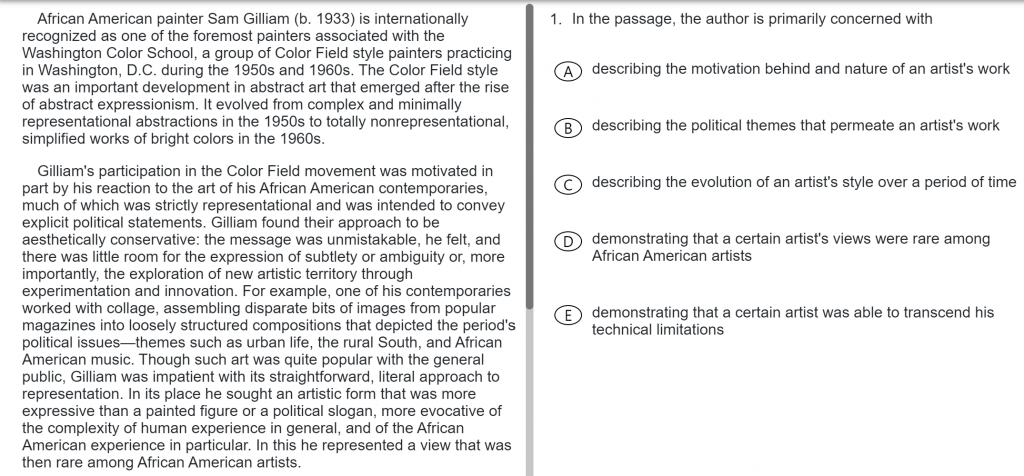

So, for this primary purpose (primarily concerned), we just need to effectively skim. My preferred way of skimming is to get the gist of the first and last sentence of each paragraph, and then fit it together.
Paragraph 1: Sam Gilliam is associated with the Color School…which evolved from minimally representational to totally nonrepresentational from the 50s to the 60s.
Paragraph 2: Gilliam’s art was reacting to his contemporaries’ political art… Gilliam’s view was rare.
Paragraph 3: Gilliam’s paintings refused to be political…Gilliam advanced the notion that the emotions of being African American could not be represented directly.
So, that’s the summary of the whole piece. I’m not trying to capture every nuance of the paragraphs, or even of the sentences I’m looking at. I just want to get an idea of what the passage is about, which should be enough for this primary purpose.
Also, although I wrote it here for obvious reasons, I would not write this on the test. Takes way too long. Just keep it in your mind.
Here, the only answer that looks reasonable would be A. It’s not political, evolving, or technically limited. And his views were rare, but we’re not really demonstrating it in the first or third paragraph (maybe in the second).
Reading Comprehension most likely to agree with strategy
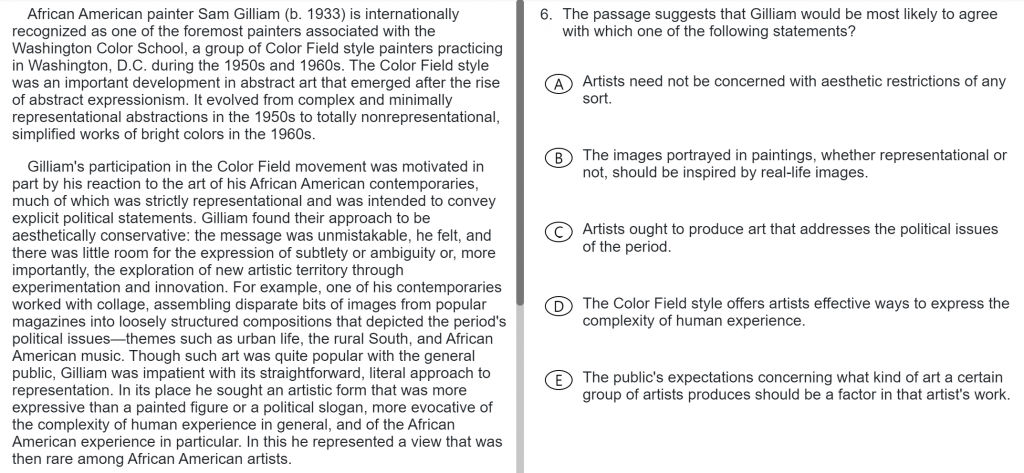

So, I definitely don’t need to skim this again. I already skimmed it once. We’re looking for what Gilliam would agree with.
Let’s go through the answer choices, and knock out any that are wrong. If I need to, I’ll go back to the passage based on the answer choice.
A seems too strong. The guy was experimental, but “any sort” is a really strong statement that’d need to be backed up.
B just sounds unlikely (why would any painter think it has to be inspired by real life images? Like you can’t paint a dragon?)
C is obviously wrong, because Gilliam was non political.
D seems good. Gilliam was part of the Color Field, and he tried to portray the human experience. So he probably feels warm about it.
E is off. No artist would believe that, and Gilliam enjoyed defying public expectations.
LSAT Reading comprehension detail strategy
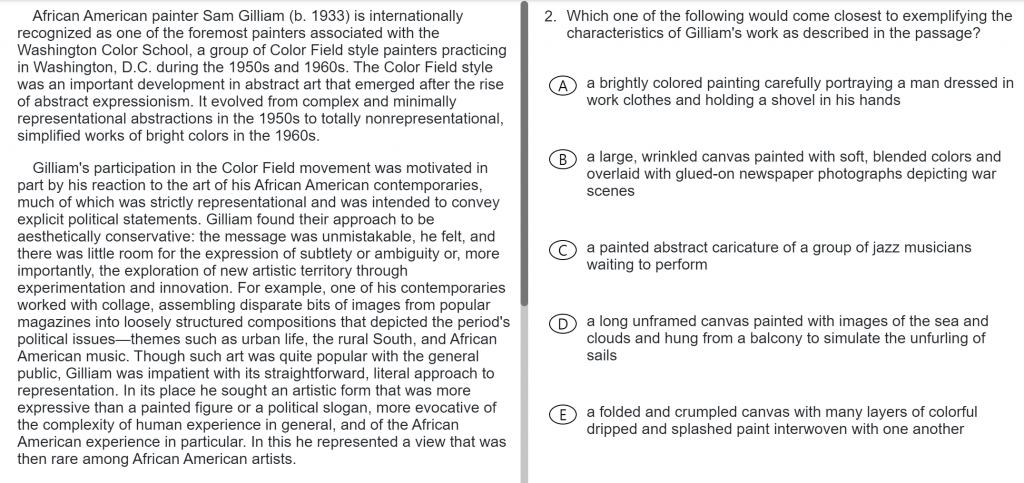

This is a detail sort of question.
First step, analyzing the question: I need to find out what Gilliam’s work is like. I have no idea right now, because that wasn’t in my skimming. However, I’m pretty sure it was in paragraph 3.
Looking through paragraph 3, I get that Gilliam draped huge pieces of loose canvas along floors and walls, to give them a sculptural quality.
E is the best there (D is tempting, but remember that Gilliam is explicitly nonrepresentational).
LSAT Reading Comprehension except strategy
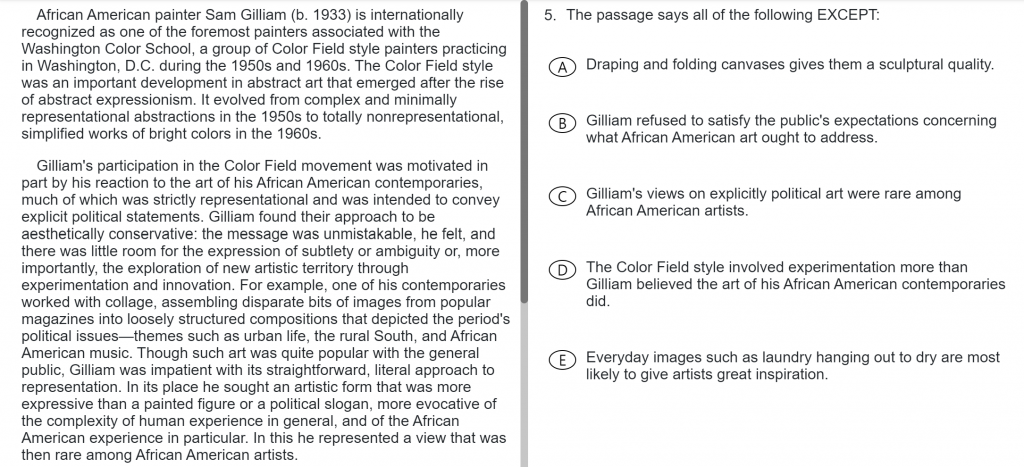

This is another detail one. It’s annoying, though, because I get zero clues in the question. I have to go through each answer individually. Hopefully I won’t have to go back to the passage.
A is correct based on the previous question.
B is correct based on skimming.
C is correct based on skimming.
D is maybe correct based on skimming.
E is incorrect because that’s way outside the scope of the passage, so E is the right answer.
Reading comprehension suggests strategy
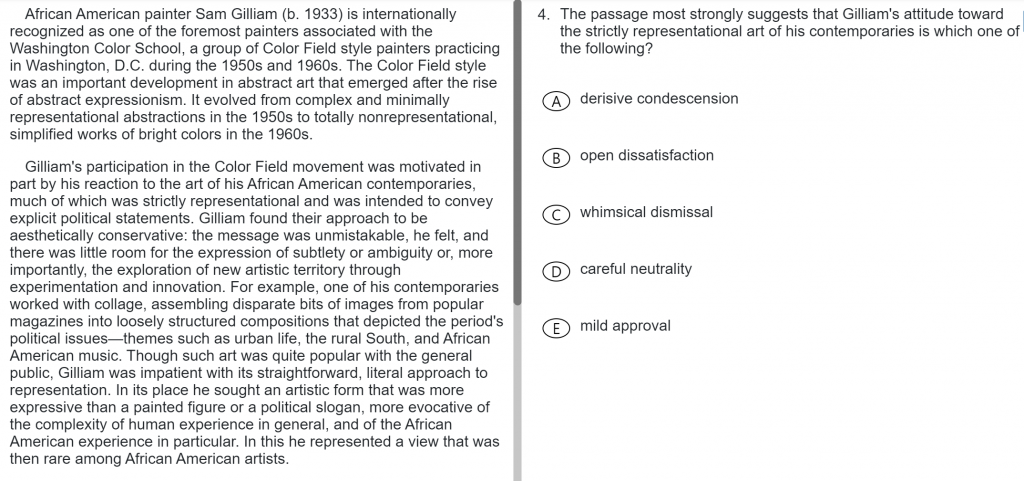

So, I definitely know from my skimming that Gilliam was deliberately non representational, but I don’t know exactly how he felt about representational art. I do know that I should look in the second paragraph.
In the second paragraph, I see the representational stuff. Gilliam thought they were aesthetically conservative, and he was impatient. So I’d say B is the closest here. Condescending is too far, and the other are too nice.
LSAT reading comprehension primarily strategy
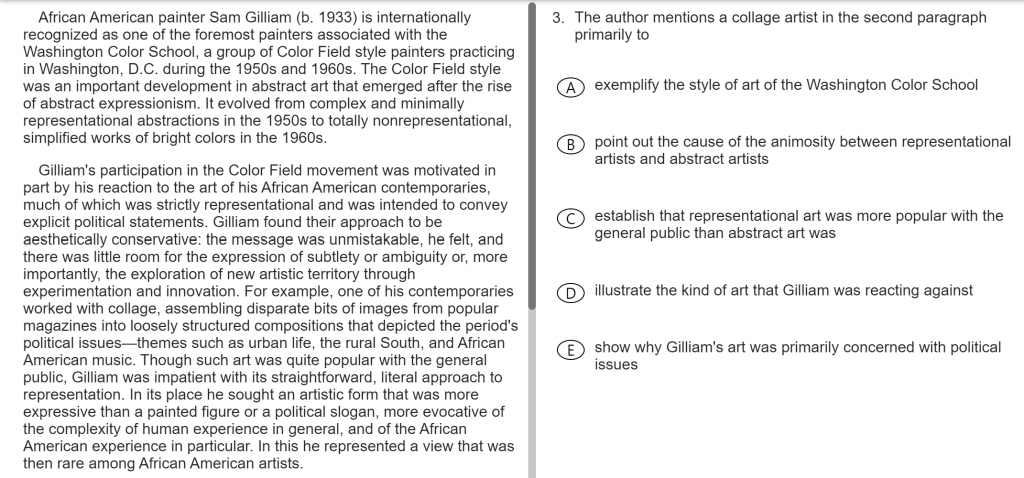

This is literally the stuff that were talking about before.
To get a clearer idea of why the author mentions something though, we should always look at the sentence before. This is reinforced by the opening of the collage sentence, which says “For example.” What is this an example of?
Well, the sentence before is talking about Gilliam’s problems with representational art. So the answer is D.
Reading comprehension paired passage primary purpose strategy
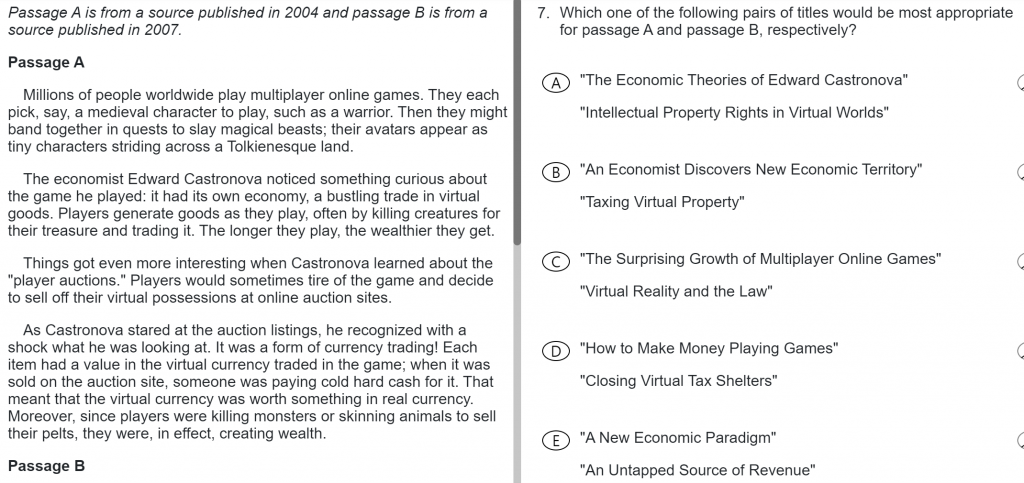
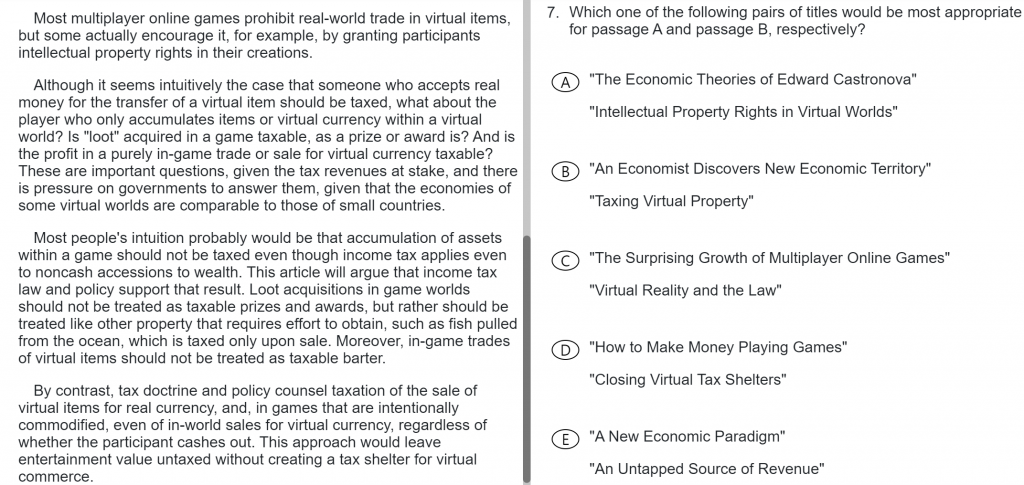
So, it’s the same strategy for paired passages: skim, questions, answers. The only difference is that you have to skim both passages, and make sure you’re clear on which passage is which. The most common mistake people make on these is mixing up or blending the passages.
Passage A:
Paragraph 1: Millions of people play online games…with quests and characters.
Paragraph 2: Online games have their own economy.
Paragraph 3: Online games have virtual auctions.
Paragraph 4: Online games have currency trading.
Passage B:
Paragraph 1: Some multiplayer games encourage real world trade in virtual items.
Paragraph 2: Should people getting paid virtual money get taxed? Maybe.
Paragraph 3: They shouldn’t get taxed on assets within a game.
Paragraph 4: They should get taxed on virtual items for real currency, and for sales for virtual currency.
B obviously fits in here.
LSAT Reading comprehension use of the phrase strategies
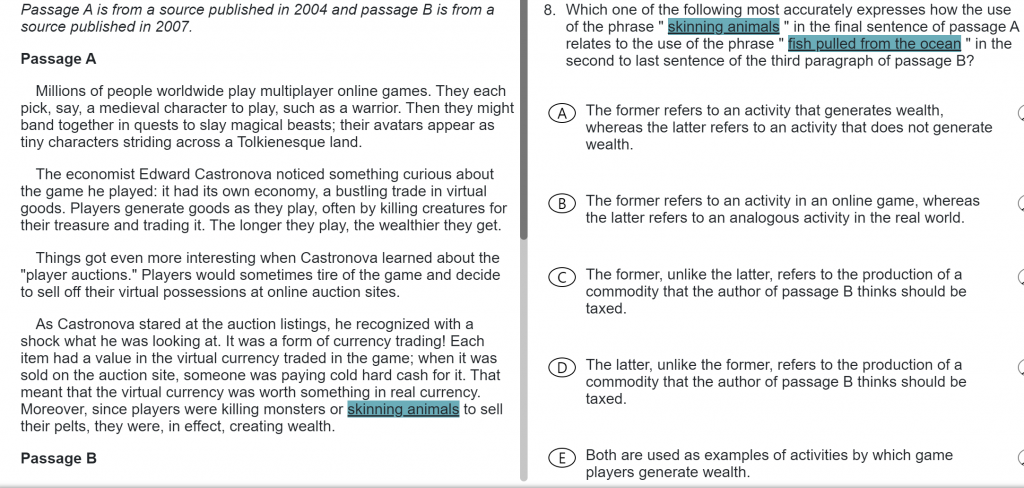
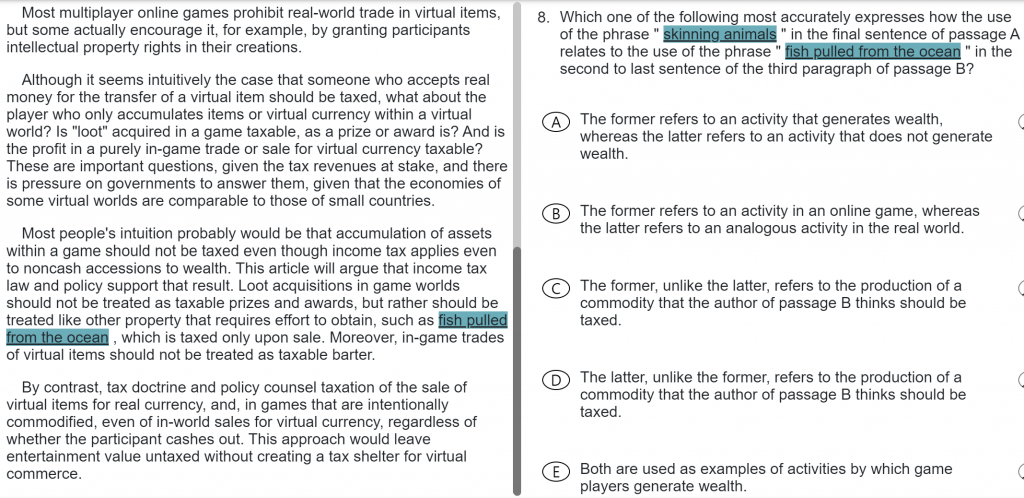
Let’s look at how they’re used. Once again, we’ll get context by reading the sentence before.
Skinning animals is used about creating wealth in a virtual world, with the idea that it’s adding onto virtual currency being worth something in real currency.
Fish pulled from the ocean is property that requires effort to obtain (sentence previous does not apply).
B fits in there perfectly (it’s skinning virtual animals, but an example of real fish).
LSAT reading comprehension paired passage analogous strategy
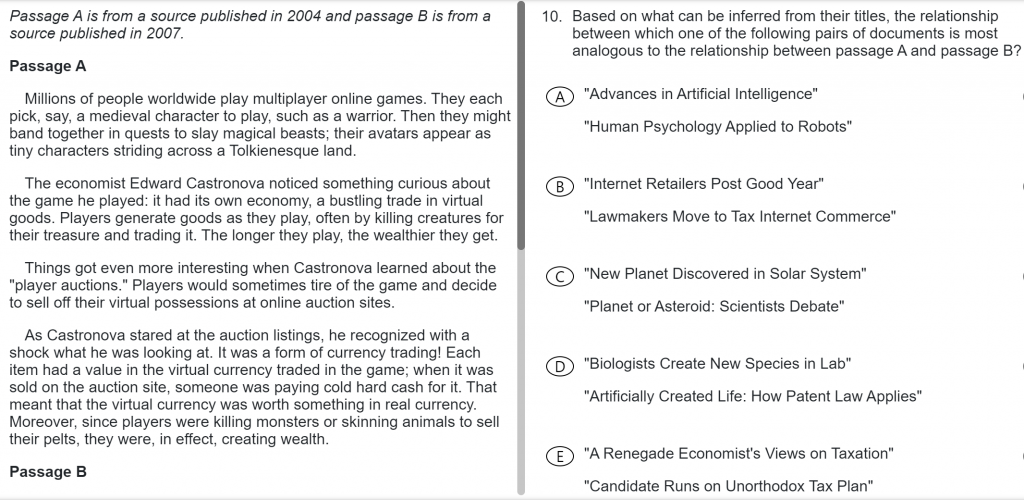
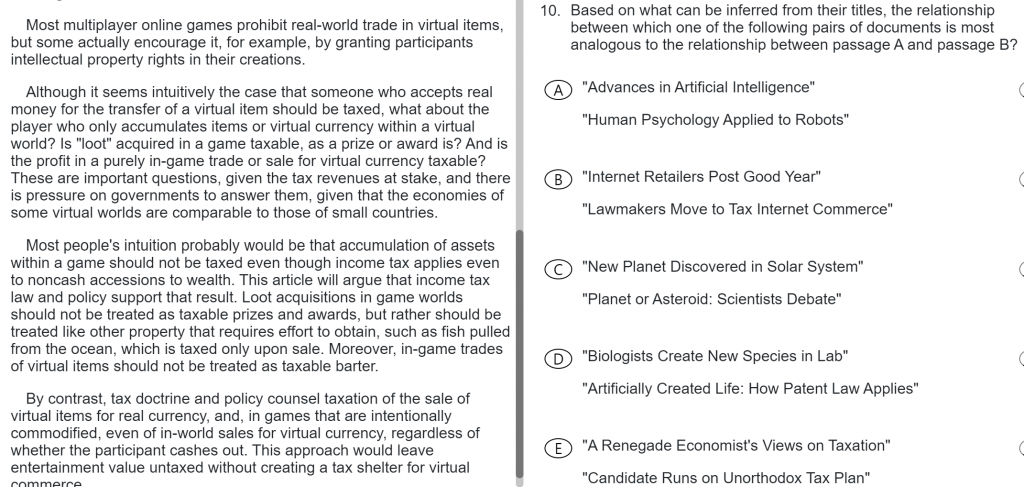
This we can just do with our knowledge from skimming.
First one was newsy and light, second one is an in-depth legal look at a certain part of the news item.
D fits in there.
LSAT reading comprehension paired passage detail
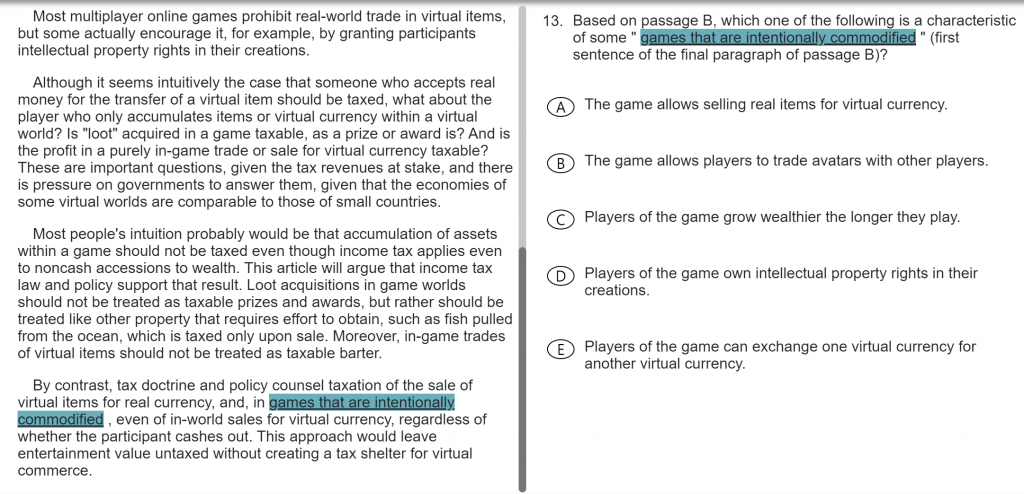
This one is just about interpreting the question, finding the right answer, and then finding the detail.
It’s annoying because the details in that paragraph aren’t great. But, generally speaking, games that are intentionally commodified encourage selling items.
A is tempting, but gets it backwards (it allows virtual items for real world).
B, is wrong. C is wrong passage (that was from passage A).
D is correct. We can remember that from our skimming, or we have to look all the way up to the first paragraph to remind ourselves about games that encourage selling items.